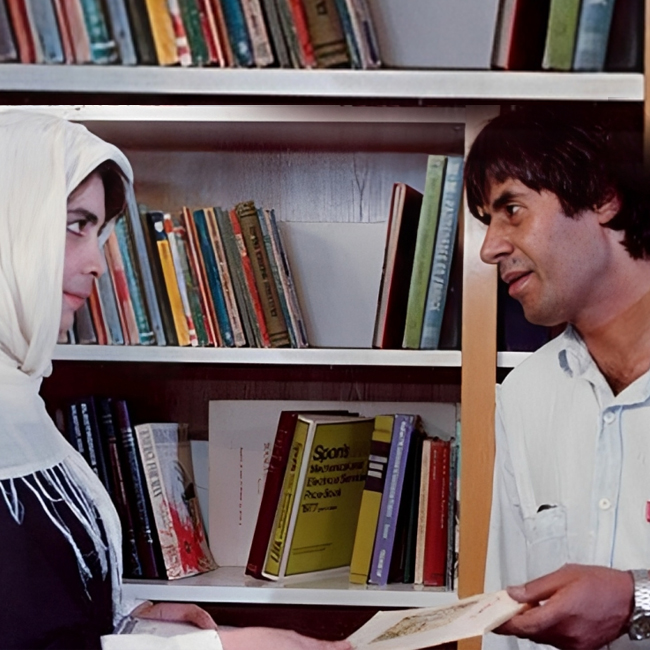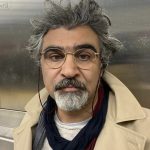
Hamoun by Dāriūsh Mehrjū’ī
Hamid Hamoun, a middle-aged Iranian sales agent and writer/intellectual in a conflicting relationship with his beloved wife Mahshid, tries to finish his doctoral thesis on Love and Faith. The thesis questions Abraham’s faith—how could Abraham as a father sacrifice his son to legitimize his belief in God? On the other hand, Mahshid files for divorce to allegedly go with her rich suitor Azimi. The film displays Hamoun’s existential challenges and his nervous breakdown in the wake of his dreams, nightmares, and loss of career as a sales agent, a modern Iranian intellectual, and a husband/father.
Dariush Mehrjui made Hamoun in a transitional moment after the eight-year war between Iran and Iraq (1980-1988), which was a major historical moment in post-revolutionary Iran. The bleak philosophical tone of the film spoke very well to the post-war climate of exhaustion, uncertainty, and frustration in Iran. However, in an interview at the end of the published filmscript of Hamoun (1994), Mehrjui states that he wrote the script based on a novel he had written years before the Islamic Revolution (1978). He states that his novel was about the lives of two brothers, one of whom he later decided to develop into the filmscript of Hamoun.
Inspired loosely by Saul Bellow’s 1963 novel Herzog, Søren Kierkegaard’s book Fear and Trembling (1843), and Sadegh Hedayat’s novella The Blind Owl (1936), Hamoun is a fragmentary look at the midlife crisis of the fictional character Hamid Hamoun and his intellectual, psychological, and spiritual engagement with the paradox of love and idealism at the philosophical/spiritual and personal levels. Nearly midway through the film, when Hamoun is confused about the paradox of Abraham’s love and how one can call it love, he asks his enlightened friend and spiritual mentor Ali Abedini about the rationalization of Abraham’s decision to
sacrifice his son for the love of God. Ali justifies it by referring to the ancient Greeks who called this sort of love divine madness.
Hamoun, one may say, displays the hopelessness and helplessness of a generation of Iranian intellectuals who failed in their experience of modernity. The critic Husein Payandeh goes further and considers Hamoun as “the archetype of Iranian intellectuals.” Hamoun’s failure is reflected in his career and domestic life and his prejudiced relationships with his wife. While Hamoun’s wife decides to leave him, he is desperately trying to keep his job as a sales agent and finish his PhD thesis. His crisis starts with the reevaluation of his own beliefs and feelings towards his life, past, and wife/love. However, on a different level of interpretation, Hamoun’s character can be seen as what Mahshid’s therapist allegedly calls a “severe psychotic case” that needs treatment.
Made of a series of flashbacks and intertwined dreams like in the stream of consciousness—which reminded some critics and cinephiles of Fellini’s surreal world of 8½ (1963)—Mehrjui’s film depicts the way that Hamoun recalls events and tries to figure out what he did wrong that made his life fall apart. Inspired by the life of Kierkegaard, who left his beloved fiancée Regine Schlegel to achieve spiritual love, Hamoun is caught between agreeing to a divorce and staying in a heated and revengeful conflict with his wife. Unable to let his wife leave him following an intentionally failed attempt to kill her, Hamoun leaves all behind and, eventually, tries to kill himself.
The film starts and ends with Hamid Hamoun’s two dreams revealing his psychological reality. In the dream at the beginning of Hamoun, there is a wide cinema screen at the top of a hill, showing Hamoun and the other inhabitants of the dream, like a mirror reflecting them to themselves: the mirroring image of the cinema screen in Hamoun’s dream addresses both reality, illusion, and their influence on Hamoun’s life in the rest of the film. In this nightmare-like dream, there are a series of essential characters in Hamoun’s real life such as his wife, her suitor, and their psychoanalyst Dr. Samavati, who appears as a goblin trying to bludgeon Hamoun to death. In this dream sequence, everyone is against Hamoun and assists the goblin in his devilish act. However, Hamoun ends with another dream sequence that Hamoun sees after trying to sink himself in the sea. In this dream, the same inhabitants of the dream try to sympathize with Hamoun and help him reconcile his relationship with his wife and his surroundings. They hold an outdoor party on the beach that symbolically references a new wedding ceremony of Hamoun and his wife Mahshid (also reminiscent of the closing sequence in Fellini’s 8½). However, amid Hamoun’s happy moments in the dream, a sudden draft of wind arrives and blows away the ceremonial elements of the wedding, such as the clothes on which the food, drinks, and fruits were placed and served. In other words, Hamoun’s happy dream is destined to be shattered. Parallel to this scene, Hamoun in total frustration and despair, runs into the sea in a suicide attempt that, in an obscure way, turns into spiritual salvation–a mystical, existential rebirth. Hamoun’s spiritual mentor and idol Ali Abedini and some lifeguards recover his dead body from the sea. After they give him CPR and mouth-to-mouth resuscitation, Hamoun starts coughing—a sign of returning to life—and the film ends.
Between the two dreams, there are different fragments of a day in Hamoun’s life, a mixture of his pleasant and bleak moments with his wife and son, often displayed in flashbacks. Through the process of Hamoun’s life, especially during Mahshid’s
therapy sessions with her therapist Dr. Samavati, the film also touches upon crucial questions of patriarchy and gender issues in Iran. This is reflected in Mahshid’s recalling a time when Hamoun slapped her on face when she came home late. Samavati’s comment ironically addresses patriarchy issues in Iran: “This is the characteristic of all Iranian men, they have bullied and have been bullied in their lives that they’ve got used to it.”
In the film, the reference to the theme of Abraham’s hope in addition to spiritual anxiety in Kierkegaard’s Fear and Trembling (1843) is mixed with a quick addressing of the German theorist of quantum mechanics, Werner Karl Heisenberg’s (1901-1976) uncertainty principle. As well, there are very brief references to several esoteric yet secular and diverse authors and poets such as the Swiss psychotherapist C. G. Jung (1875-1961), the German/Swiss author and painter Hermann Hesse (1877-1962), the American author Jerome David Salinger’s (1919 – 2010) novel Franny and Zooey (1961), the Iranian philosopher and post-modern cultural theorist Dariush Shayegan (1935-2018), and the Iranian author Ahmad Shamloo (1925-2000).
The fragmentary Hamoun is spiced and united by the marvelous editing of Hasan Hasandoost and the Iranian composer Naser Chashm-Azar’s interpretation of the German composer Johan Sebastian Bach’s (1685-1750) Violin Concerto Adagio. The eclectic combination of secularism and spirituality provided viewers with a great opportunity for thought experiments. Cinema was no longer merely an entertaining medium: by including diverse concepts from many cultures, well incorporated into the everyday life of a desperate Iranian intellectual, Hamoun showed the transforming power of film, of thinking, and of thinking through film. Accordingly, the film was a big success at the box office and among many film critics during this transitional period. At the eighth Fajr Film Festival, Hamoun received five “Crystal Simurgh” awards in addition to the Jury’s Special Award.
The direct references to religious beliefs and motifs such as faith, Abraham as the father of faith, and the search for a reconciliation of Hamoun’s emotional and philosophical/spiritual crisis through literature and philosophy makes Hamoun a complex film that evoked conflicting critical responses among the new and older generations in Iran. Many admired Mehrjui for his honest description of the existential doubt of an Iranian intellectual. However, there were a few that detested the film. Morteza Avini, a post-revolutionary socio-cultural theorist with strong anti-Western sentiments, debunked Mehrjui for simply flirting with mysticism. To “defend the realm of religion,” Aviny condescended Hamoun as simply a dishonest “mystical performance/gesture” full of “Hamoun-esque mysticism” that has nothing to do with an authentic “jump of faith” like that of Abraham.
To better understand Hamoun, one needs to note that religiosity has been embedded in almost all social interactions and events in Iran because Islam has been the official religion of Iran since its establishment after the seventh-century conquest. This religiosity has been reinforced after the Islamic Revolution of 1979 which overthrew the Shah and replaced it with the Islamic Republic regime. However, the intervention and translation of largely Eurocentric philosophies and literature in modern Iran diverted the attention of the educated and intellectually curious people toward a more secular realm of philosophical and critical analysis of sociocultural events. In addition, the climate of frustration in the postwar period made some Iranian intellectuals and artists question their past idealist endeavors
for freedom and modernization, and an existential discourse grew among some authors and filmmakers.
One of the reasons that the project of secularization and modernization has been distorted or partial in Iran might be the unsettled intellectual climate, suspended between religiosity and the Eurocentric fashion of thinking. By making Hamoun, Mehrjui observes and investigates the old struggle between tradition/modernity and religion/secularism in Iran. Perhaps one interpretation of Hamoun’s desperate condition—being caught between tradition and modernity—is the struggle that Iranians have been preoccupied with since the Constitutional Revolution (1905-19011), which (despite all its shortcomings) was supposed to bring social laws into practice, as the first step of modernization.
Inspired by the popularity of Hamoun as a cult movie, especially among the Iranian youth, in 2006 the Iranian director Mani Haghighi made the hilarious documentary Hamoun-bazha (Hamoun Lovers, 2006). The film investigated how Hamoun related to Iranian youth of the time. Based on Haghighi’s film, the acclaimed playwright and theatre director Mohammad Rahmanian staged a play in 2015 with the same title.
Dariush Mehrjui (1939), as one of the major contributors to Iranian New Wave Cinema, had first studied philosophy at UCLA; however, his interest in cinema, as a means of intellectual and sociocultural inquiry led him to filmmaking in 1967 with his first feature film Almaas 33 (Diamond 33). Mehrjui’s second film The Cow (1969) won FIPRESCI Prize at the 32nd Venice International Film Festival (1971) and was among the first Iranian films that introduced Iranian cinema to the world.
Cite this article

Dariush Mehrjui
Dariush Mehrjui
Fath-ali Oveisi
Hosein Sarshar
Jalal Moghadam
Bita Farahi
Ezatollah Entezami
Khosro Shakibaie
Naser Chasm-azar [based on Johan Sebastian Bach’s (1685-1750) Violin Concerto Adagio]
Plot
Hamid Hamoun, a middle-aged Iranian sales agent and writer/intellectual in a conflicting relationship with his beloved wife Mahshid, tries to finish his doctoral thesis on Love and Faith. The thesis questions Abraham’s faith—how could Abraham as a father sacrifice his son to legitimize his belief in God? On the other hand, Mahshid files for divorce to allegedly go with her rich suitor Azimi. The film displays Hamoun’s existential challenges and his nervous breakdown in the wake of his dreams, nightmares, and loss of career as a sales agent, a modern Iranian intellectual, and a husband/father.



